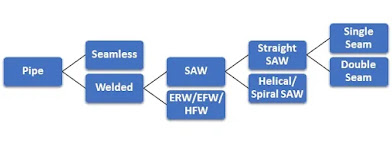The pipe is a straight pressure-tight cylindrical hollow, used in the piping system to transport liquid, gas, and sometimes solids.
Pipe is used in process plant , chemical plants , power plant, building slurry, gas transmission, drainage service, cross country transportation fluids , vapours, slurries, solids etc. it may be under severe Temperature, Pressure , Flow requirement.
https://en.wikipedia.org/wiki/Pipe_(fluid_conveyance)
- SEAM LESS PIPES MANUFACTURING PROCESS
- SPIRAL PIPES MANUFACTURING PROCESS
Difference Pipe vs. Tube
WHAT IS A PIPE?
The most important dimension for a steel pipe is the inside diameter (“pipe ID”), which indicates the rough (not the exact) fluid conveyance capacity of the tubular. The ID is expressed in “NPS” or “DN” (nominal pipe size, or bore size).
The pipe outside diameter (OD) does not match the nominal size for pipes below NPS 14 inches (a 2 inches pipe, for instance, has an internal flow capacity of approximately 2 inches, but has an outside diameter of 2.375 inches).
For pipes of a given NPS, the pipe outside diameter is fixed, whereas the pipe inside diameter decreases by increasing schedule values (pipe wall thickness).
The most important mechanical parameters for pipes are the pressure rating, the yield strength, and the ductility.
The standard combinations of pipe nominal diameter and wall thickness (schedule) are covered by the ASME B36.10 and ASME B36.19 specifications (respectively, carbon and alloy pipes, and stainless steel pipes).
PIPE INSIDE DIAMETER CALCULATOR
As mentioned, the outside diameter of pipes of a specific NPS is constant but the inside diameter of the pipe (ID) changes depending on the pipe schedule.
The pipe ID can be easily calculated, as long as the pipe NPS and schedule are known.
The pipe ID can be calculated by deducting from the pipe NPS the pipe wall thickness multiplied by 2 (the pipe WT can be taken from the schedule).
Example: for a 12 NPS pipe (DN 300 mm), schedule 40, the pipe outside diameter and the wall thickness are 12.75 inches (324 mm) and 0.406 inches (10.4 mm).
Therefore, the pipe ID (internal diameter) is 12.75 inches – 2 x 0.406 inches = 11.94 inches, or Pipe ID = 324 mm – 2 x 10.4 mm = 303.2 mm.
It should be noted that this calculation is just theoretical, as pipes have a wall thickness tolerance which is generally +/-12.5% for ASME pipes. Hence the actual ID of a given pipe may differ by +/- 12,5% from the theoretical value.
WHAT IS A TUBE?
The word “tube” refers to round, square, rectangular, and oval hollow sections used for pressure equipment, for mechanical applications, and for instrumentation systems.
Tubes are designated by their outside diameter and wall thickness, which are exact measures in inches or millimeters. For tubes, the difference between the outside diameter and the wall thickness, multiplied by two, defines the inside diameter of the tube.
PIPE VS TUBE
| PIPE VS TUBE | STEEL PIPE | STEEL-TUBE | |
| 1 | Key Dimensions (Pipe and Tube Size Chart) | The most important dimension for a pipe is the inside diameter (ID), expressed in NPS (nominal pipe size) or DN (nominal diameter), which defines its fluid conveyance capacity. The NPS does not match the true inside diameter, it is a rough indication | The most important dimensions for a steel tube are the outside diameter (OD) and the wall thickness (WT). These parameters are expressed in inches or millimeters and express the true dimensional value of the hollow section. |
| 2 | Wall Thickness | The thickness of a steel pipe is designated with a “Schedule” value (the most common are Sch. 40, Sch. STD., Sch. XS/XH, Sch. XXS). Two pipes of different NPS and same schedule have different wall thicknesses in inches or millimeters. | The wall thickness of a steel tube is expressed in inches or millimeters. For tubing, the wall thickness is measured also with a gage nomenclature (BWG, SWG). |
| 3 | Types of Pipes and Tubes (Shapes) | Round only | Round, rectangular, square, oval |
| 4 | Production range | Extensive (up to 80 inches and above) | A narrower range for tubing (up to 5 inches), larger for steel tubes for mechanical applications |
| 5 | Tolerances (straightness, dimensions, roundness, etc) and Pipe vs. Tube strength | Tolerances are set, but rather loose. Strength is not the major concern. | Steel tubes are produced to very strict tolerances. Tubulars undergo several dimensional quality checks, such as straightness, roundness, wall thickness, surface, during the manufacturing process. Mechanical strength is a major concern for tubes. |
| 6 | Production Process | Pipes are generally made to stock with highly automated and efficient processes, i.e. pipe mills produce on a continuous basis and feed distributors stock around the world. | Tubes manufacturing is more lengthy and laborious |
| 7 | Delivery time | Can be short | Generally longer |
| 8 | Market price | Relatively lower price per ton than steel tubes | Higher due to lower mills productivity per hour, and due to the stricter requirements in terms of tolerances and inspections |
| 9 | Materials | A wide range of materials is available | Tubing is available in carbon steel, low alloy, stainless steel, and nickel-alloys; steel tubes for mechanical applications are mostly of carbon steel |
| 10 | End Connections | The most common are beveled and plain ends | Threaded and grooved ends are available for quicker connections on site |
















.jpg)



Useful post, You can also visit Round Bars Manufacturers in India
ReplyDeleteCurrently it sounds like Expression Engine is the preferred blogging platform available right now. (from what I've read) Is that what you're using on your blog?Jindal Hissar Dealers Delhi NCR
ReplyDelete